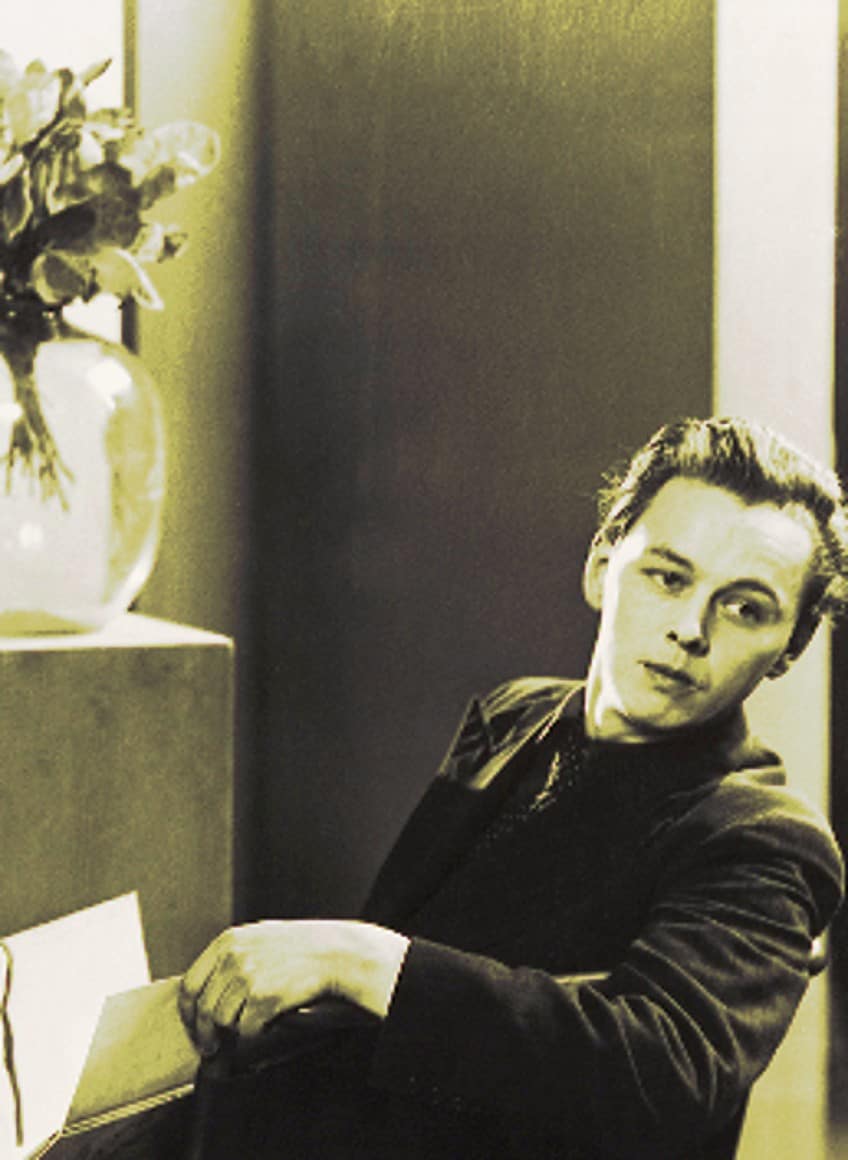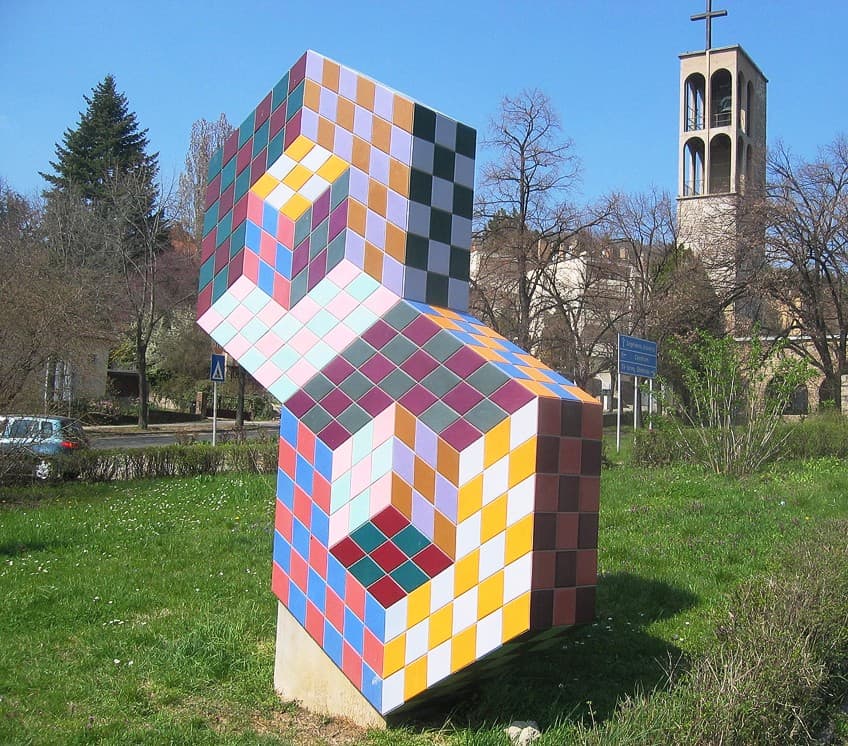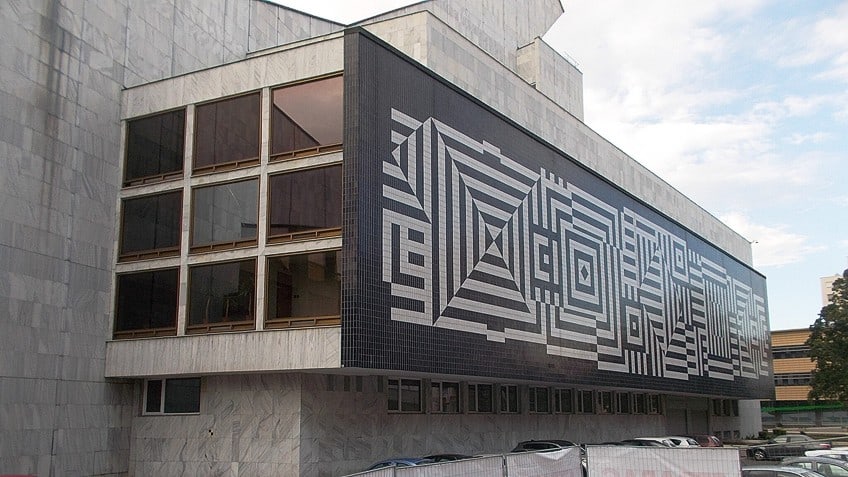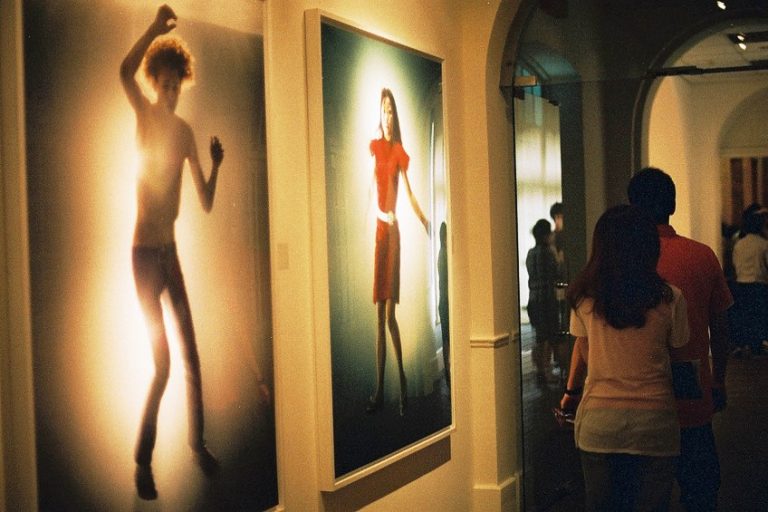Victor Vasarely – Explore the Life and Art of the Iconic Op Artist
Discover the mesmerizing world of Victor Vasarely, an artistic visionary and Op art pioneer whose groundbreaking creations continue to captivate audiences worldwide. Renowned for his iconic Victor Vasarely artworks, he remains an enduring figure in the realm of modern art. Join us on a journey through the life and works of this extraordinary artist, as we delve into the captivating realm of Op art and explore the enduring legacy of Victor Vasarely.
Victor Vasarely: The Op Art Pioneer
| Name | Victor Vasarely |
| Date of Birth | 9 April 1906 |
| Place of Birth | Pécs, Hungary |
| Date of Death | 15 March 1997 |
| Nationality | Hungarian-French |
| Periods | Op art, Modern art, Cubism, and Hard-edge painting |
Victor Vasarely’s artistic journey exemplifies the power of creative vision and the transformative potential of art in reshaping the way we perceive the world around us. Through his innovative creations, he remains an artistic pioneer whose influence continues to reverberate throughout the annals of art history.
Childhood
Victor Vasarely was born on April 9, 1906, in Pécs, Hungary, into a family of mixed heritage, with Hungarian and Polish roots. Growing up, young Vasarely exhibited an excited interest in the arts and was especially pulled toward colors, shapes, and visual patterns. His fascination with art started at a tender age, as he spent countless hours sketching and experimenting with various artistic techniques.

Despite initial encouragement from his family, he faced skepticism from his father, who preferred a more practical career path for his son. Nevertheless, Vasarely’s determination to pursue his artistic passion would soon overcome these obstacles, setting him on a path toward becoming a groundbreaking figure in the art world.
Influences
Vasarely’s early artistic influences were diverse and encompassed various styles, ranging from the Hungarian folk art he encountered in his hometown to the avant-garde art movements that were gaining prominence in Europe during the early 20th century. Artists like Wassily Kandinsky (1866-1944) and Kazimir Malevich (1879-1935), who explored abstract forms and geometric shapes, left a profound impact on Vasarely’s artistic vision. Moreover, the works of Bauhaus artists and their emphasis on the harmony between art and technology significantly influenced his artistic philosophy.
Training and Early Artworks
In pursuit of formal artistic training, Vasarely enrolled at the Podolini-Volkmann Academy in Budapest in 1925. Here, he honed his skills in traditional painting and drawing techniques, but it was during his time at the Mühely Academy, also known as the Budapest Bauhaus, that Vasarely found his true artistic voice.
The academy’s emphasis on the relationship between art and industry profoundly shaped Vasarely’s approach to art, and he began to explore the potential of geometric abstraction and optical effects in his early artworks.
Major Career Achievements
Vasarely’s breakthrough came when he moved to Paris in 1930, a city that was bustling with artistic innovation. In the 1940s and 1950s, Vasarely gained recognition for his innovative use of geometric patterns and optical illusions, which he referred to as “kinetic visuality.”
He started to achieve international acclaim, and his paintings were shown in distinguished galleries and museums around the world. One of his significant achievements was the establishment of the Vasarely Foundation in Aix-en-Provence, France, in 1976, which showcased his extensive collection and further cemented his artistic legacy.
His Influence on Op Art
Victor Vasarely is rightfully hailed as the pioneer of Op art, short for “Optical Art.” This art movement emerged in the 1960s and aimed to create visual experiences that challenged viewers’ perception and created the illusion of movement and depth through precise geometric patterns and optical effects. Vasarely’s innovative use of contrasting colors and geometric shapes became synonymous with the Op art movement, inspiring numerous artists to explore similar visual techniques and engage audiences in immersive optical experiences.
His Influence on Modern Art
Vasarely’s contributions to modern art extended beyond the Op art movement. He bridged the gap between fine art and commercial design, firmly believing that art should be accessible to the masses. Vasarely’s exploration of the relationship between art and technology prefigured the digital age’s fascination with visual effects and computer-generated art.
His forward-thinking approach resonated with contemporary artists and paved the way for new forms of artistic expression that blurred the boundaries between fine art, design, and technology.
His Influence on Cubism
While Victor Vasarely is primarily associated with Op art, his early exposure to modern art movements, including Cubism, significantly influenced his artistic development. Cubism, developed by Pablo Picasso and Georges Braque in the early 20th century, aspired to depict objects and subjects from various viewpoints simultaneously, fragmenting and reassembling them in abstract forms. Although Vasarely’s work moved away from the complex Cubist compositions, the movement’s exploration of geometric shapes and abstraction left a lasting imprint on his artistic style.

Victor Vasarely’s Art: A Synthesis of Art and Socio-Political Climate
Victor Vasarely’s artistic journey unfolded against the backdrop of significant socio-political developments in both Hungary and France, where he spent crucial periods of his life. This section of the article delves into the socio-political climate that influenced Vasarely’s art and examines how his career was shaped by the prevailing cultural, economic, and political forces of the times.
Hungary: A Turbulent Birthplace
Vasarely’s formative years were spent in Hungary, a country marked by profound political changes and artistic fervor during the early 20th century. The aftermath of World War I saw Hungary’s transition from an empire to a republic, and the following decades witnessed the rise of nationalism, economic instability, and the threat of fascism. During this period, the Hungarian avant-garde art scene flourished, and Vasarely found inspiration in the rich heritage of Hungarian folk art and traditional crafts.
The emergence of the Bauhaus movement also had a significant impact on Vasarely’s early artistic development, introducing him to the principles of geometric abstraction and the integration of art with industry.
The Move to Paris: An Artistic Epicenter
In 1930, Vasarely made a life-changing decision to relocate to Paris, which was at the time the epicenter of the art world. Paris offered a diverse and vibrant artistic community that fostered creativity and innovation. It was here that Vasarely encountered the works of modernist masters like Pablo Picasso (1881-1973), Fernand Léger (1881 – 1955), and Wassily Kandinsky, who pushed the boundaries of art with their revolutionary approaches.
In the backdrop of political tensions leading up to World War II, Paris became a haven for many artists seeking refuge from oppression. Vasarely’s geometric abstractions gained attention in the burgeoning art scene and laid the groundwork for what would become his pioneering Op art movement.
Art and Post-War Reconstruction
The aftermath of World War II brought about an urgent need for reconstruction and rebuilding in Europe. In the post-war period, Vasarely’s art reflected a sense of optimism and aspiration for the future. His use of bright colors and dynamic patterns conveyed a vision of a harmonious world marked by progress and technological advancement.
As Europe sought to heal and reinvent itself, Vasarely’s art provided a visual language that transcended borders and languages, resonating with a diverse audience seeking solace and renewal through art.
Embracing Technology and Mass Production
In line with the prevailing spirit of the 20th century, Vasarely embraced technology and mass production in his art. He firmly believed in the democratization of art and sought to make it accessible to all, breaking down the traditional barriers between high art and commercial design. This philosophy resonated with the rise of consumer culture and the increasing interconnectedness of the global community.

Unraveling the Technical Marvels of Victor Vasarely’s Artworks
With an unwavering dedication to precision and a keen eye for detail, Vasarely employed an array of techniques and materials to bring his imaginative visions to life. This section of the article delves into the technical characteristics that underpin the brilliance of Vasarely’s art, revealing the meticulous craftsmanship and innovative methods that continue to captivate audiences worldwide.
Geometric Precision
At the heart of Vasarely’s art lies a deep fascination with geometric forms. His meticulous use of rulers, compasses, and stencils allowed him to achieve unparalleled precision in creating his mesmerizing patterns and optical effects.
Every line, curve, and shape in his artworks is executed with utmost accuracy, resulting in compositions that resonate with perfect symmetry and balance.
Optical Illusions
Vasarely’s mastery of optical illusions was a hallmark of his artistic brilliance. By strategically arranging contrasting colors and geometric patterns, he managed to create a sense of movement, depth, and vibration on the flat canvas. These optical illusions engage the viewer in an interactive experience, making them question their own perception and revealing the dynamic nature of his art.
Printmaking Techniques
Vasarely was a pioneer in the use of printmaking techniques to achieve widespread dissemination of his art. He explored various printmaking methods, such as silkscreen, lithography, and serigraphy, to produce multiple editions of his artworks. These techniques allowed him to maintain the consistency and precision that were integral to his artistic vision while making his art accessible to a broader audience.
Experimentation With Materials
Throughout his career, Vasarely was a relentless experimenter with materials. From traditional oil paints to modern acrylics and industrial materials, he fearlessly explored a wide range of media to achieve the desired visual impact.
His use of diverse materials added texture and depth to his artworks, enhancing the overall sensory experience for the viewer.
Color Theory and Harmony
A master of color theory, Vasarely employed colors with great intention and sophistication. He understood how colors interacted with one another, manipulating hues, tones, and saturation to achieve maximum visual impact. His art frequently featured daring, resonant colors, producing a sense of liveliness and motion within the meticulously constructed geometric patterns.

Graphical and Concept Analysis of Zebra (1937)
| Title | Zebra |
| Date | 1937 |
| Medium | Acrylic on canvas |
| Dimensions (cm) | 52 x 60 |
| Style | Op Art |
| Location | Private collection |
Zebra (1937) is a striking and iconic artwork by Victor Vasarely, an artist celebrated for his pioneering contributions to Op art. This painting, created during a critical period of Vasarely’s career, exemplifies his exploration of geometric abstraction and optical illusions.
Visual Analysis
At first glance, Zebra presents a mesmerizing visual of alternating black and white stripes. The composition is precisely structured, with each stripe meticulously aligned to create an illusion of movement. Vasarely’s mastery of geometric forms is evident in the perfect symmetry and balance of the painting.
Optical Effects
The juxtaposition of the black and white stripes generates a dynamic visual effect that appears to oscillate and vibrate. The artwork seems to pulsate, playing tricks on the viewer’s perception. This manipulation of visual perception is a hallmark of Vasarely’s Op art style, engaging the audience in an immersive and interactive experience.
Contrast and Depth
The stark contrast between the black and white stripes enhances the artwork’s optical impact. The colors seem to interact with one another, creating a sense of deepness and dimensionality on the flat canvas.
As the viewer’s gaze moves across the painting, the stripes appear to advance and recede, blurring the boundaries between foreground and background.
Conceptual Analysis
Zebra epitomizes Vasarely’s fascination with the nature of human perception. By manipulating geometric patterns and contrasting colors, Vasarely challenges our understanding of reality and pushes the boundaries of visual experience. The artwork invites viewers to question their own perception, blurring the line between what is seen and what is merely inferred.
A Study of Rhythm and Movement
The carefully crafted arrangement of stripes in Zebra creates a sense of rhythm and motion within the static canvas. The artwork conveys a feeling of energy and dynamism, as if the stripes are in constant motion, capturing the essence of a living creature.
Vasarely’s use of repetition and pattern engenders a sense of continuity and infinite expansion, enhancing the artwork’s visual impact.
Symbolism and Universality
While the title Zebra suggests an association with the animal world, Vasarely’s artwork transcends literal representation. The zebra’s stripes become a metaphor for the universal principles of pattern and symmetry found in nature and the cosmos. In this sense, Zebra becomes an exploration of the underlying order and harmony that governs the universe.
In conclusion, the artistic genius of Victor Vasarely shines brightly through his groundbreaking Op art creations and impeccable technical prowess. His mesmerizing Victor Vasarely artworks, characterized by geometric precision, optical illusions, and innovative use of materials, have left an indelible mark on the art world. As an Op Art pioneer, Vasarely’s art continues to captivate audiences and inspire generations of artists to push the boundaries of perception and creativity.
Frequently Asked Questions
When Did Victor Vasarely Die?
Victor Vasarely, the pioneering artist known for his significant contributions to Op art, sadly passed away on March 15, 1997, at the age of 90. Despite his physical departure, his artistic legacy continues to thrive, and his influential body of work remains evidence of his ingenious spirit and lasting influence on the world of modern art.
What Is Op Art?
Op art, short for Optical Art, is an influential art movement that emerged in the 1960s. Characterized by its focus on creating optical illusions and visual effects, Op art seeks to engage and challenge the viewer’s perception and sensory experience. Artists within this movement use precise geometric patterns, contrasting colors, and meticulous arrangements to create artworks that appear to pulsate, vibrate, or move, despite being static images. Op art plays with the viewer’s visual perception, often inducing a sense of depth, movement, or disorientation. The movement’s goal is to explore the dynamic relationship between art and the human eye, encouraging viewers to question their own understanding of reality and visual cognition. Victor Vasarely is considered to be one of the pioneers of Op art, and his innovative contributions have profoundly shaped the movement’s development and enduring popularity.
Nicolene Burger is a South African multi-media artist, working primarily in oil paint and performance art. She received her BA (Visual Arts) from Stellenbosch University in 2017. In 2018, Burger showed in Masan, South Korea as part of the Rhizome Artist Residency. She was selected to take part in the 2019 ICA Live Art Workshop, receiving training from art experts all around the world. In 2019 Burger opened her first solo exhibition of paintings titled, Painted Mantras, at GUS Gallery and facilitated a group collaboration project titled, Take Flight, selected to be part of Infecting the City Live Art Festival. At the moment, Nicolene is completing a practice-based master’s degree in Theatre and Performance at the University of Cape Town.
In 2020, Nicolene created a series of ZOOM performances with Lumkile Mzayiya called, Evoked?. These performances led her to create exclusive performances from her home in 2021 to accommodate the mid-pandemic audience. She also started focusing more on the sustainability of creative practices in the last 3 years and now offers creative coaching sessions to artists of all kinds. By sharing what she has learned from a 10-year practice, Burger hopes to relay more directly the sense of vulnerability with which she makes art and the core belief to her practice: Art is an immensely important and powerful bridge of communication that can offer understanding, healing and connection.
Nicolene writes our blog posts on art history with an emphasis on renowned artists and contemporary art. She also writes in the field of art industry. Her extensive artistic background and her studies in Fine and Studio Arts contribute to her expertise in the field.
Learn more about Nicolene Burger and the Art in Context Team.
Cite this Article
Nicolene, Burger, “Victor Vasarely – Explore the Life and Art of the Iconic Op Artist.” Art in Context. August 8, 2023. URL: https://artincontext.org/victor-vasarely/
Burger, N. (2023, 8 August). Victor Vasarely – Explore the Life and Art of the Iconic Op Artist. Art in Context. https://artincontext.org/victor-vasarely/
Burger, Nicolene. “Victor Vasarely – Explore the Life and Art of the Iconic Op Artist.” Art in Context, August 8, 2023. https://artincontext.org/victor-vasarely/.











